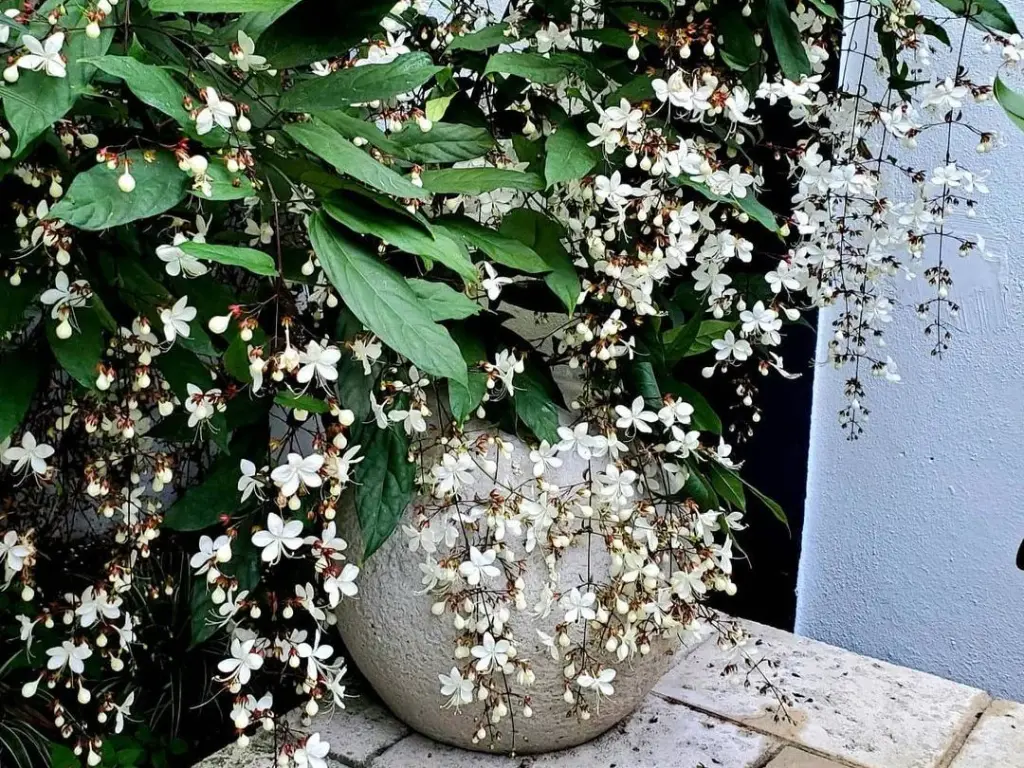Clerodendrum wallichii ([1]), also known as Wallich’s glory-bower, bridal veil, or nodding clerodendron, is a medium to large-sized shrub native to southern Asia. This stunning plant is well-regarded for its striking white flowers and glossy, dark green leaves. Mature specimens can reach heights of 6-13 feet, with an upright to arching, openly branched growth habit.
The leaves of the Clerodendrum Wallichii are narrowly oblong, growing up to 7 inches long and 1.5 inches wide, giving the plant a distinctive appearance. What makes this plant truly stand out is its pendulous clusters of small, white flowers, which bloom seasonally, typically in autumn. These clusters can reach 1 foot in length and appear at the terminal ends of the branches, making the plant a beautiful addition to any garden or landscape.

The plant produces round, glossy fruits that start off green and mature to black, with the fruit being surrounded by bright pink sepals, adding another layer of visual interest. The plant’s genus name, Clerodendrum, derives from the Greek words kleros (meaning “chance”) and dendron (meaning “tree”). The species name, wallichii, honors Nathaniel Wallich, a Danish botanist who extensively collected plants in India during the colonial era (1786–1854).
With its vibrant flowers and unique appearance, Clerodendrum Wallichii is not only a favorite among gardeners but also a piece of botanical history.
In this comprehensive guide, we’ll walk you through everything you need to know to help your Clerodendrum Wallichii grow strong and healthy. We’ll cover everything from ideal growing conditions to common problems you might encounter.
How to Care for Clerodendrum Wallichii

Ideal Growing Conditions for Clerodendrum Wallichii
Like many tropical plants, Clerodendrum Wallichii thrives in specific conditions that mimic its natural habitat. To ensure your plant stays healthy, follow these tips for the perfect environment:
-
Light Requirements: This plant loves bright, indirect sunlight. Place it in a location that gets plenty of light, but avoid direct sunlight for extended periods, as it may scorch the leaves. If you’re growing it indoors, a south or west-facing window is ideal.
-
Soil: Clerodendrum Wallichii prefers well-draining soil with a slightly acidic to neutral pH (6.0–7.0). You can use a regular potting mix with added perlite or sand for better drainage. The plant doesn’t like to sit in soggy soil, which can lead to root rot.
-
Temperature: Being a tropical plant, Clerodendrum Wallichii thrives in warm temperatures. It’s best kept in an environment with temperatures between 60°F and 80°F (15°C–27°C). Avoid placing it in cold drafts or areas with sudden temperature changes.
You may like:
- How to Grow Lantana Plants Like a Pro
- How to Get Passionflower to Bloom: Expert Tips for Vibrant Flowers
- Lantana Rose Sunrise: The Ultimate Guide to Growing This Vibrant Beauty
Watering Tips for Clerodendrum Wallichii
Watering can be tricky, but with the right balance, your plant will flourish. Here’s what you need to know:
-
Frequency: Water your Clerodendrum Wallichii when the top inch of soil feels dry. The plant prefers consistently moist soil, but it should never be waterlogged. Always ensure the pot has good drainage to prevent water from accumulating at the bottom.
-
Signs of Overwatering: If the leaves begin to yellow or droop, it could be a sign of overwatering. Ensure your pot is draining well, and adjust your watering schedule as necessary.
Fertilizing Your Clerodendrum Wallichii
To encourage healthy growth and vibrant blooms, fertilizing is key:
-
Best Fertilizer: A balanced, water-soluble fertilizer is perfect for this plant. Use one with equal proportions of nitrogen, phosphorus, and potassium, such as a 10-10-10 formula.
-
When to Fertilize: Fertilize your Clerodendrum Wallichii every 4–6 weeks during the growing season (spring and summer). Avoid fertilizing in the dormant months (fall and winter) when the plant’s growth slows down.
Common Problems and How to Solve Them

Pests and Diseases That Affect Clerodendrum Wallichii
This plant is not immune to pests. Common pests you might encounter include aphids, mealybugs, and whiteflies. Here’s how to tackle them:
-
Prevention: To prevent pest infestations, regularly inspect your plant, especially the undersides of the leaves, for any signs of pests. Keep the area around the plant clean and ensure good air circulation.
-
Treatment: If pests appear, treat your plant with insecticidal soap or neem oil. Both are natural options that will help eliminate pests without harming the plant.
Yellowing Leaves and Other Symptoms
If you notice your Clerodendrum Wallichii’s leaves turning yellow, it could be due to a few reasons:
-
Overwatering: As mentioned earlier, overwatering can lead to yellowing leaves. Ensure your plant isn’t sitting in soggy soil, and adjust your watering schedule accordingly.
-
Nutrient Deficiency: Yellow leaves can also be a sign of nutrient deficiency, especially nitrogen. In this case, it’s best to fertilize your plant with a balanced fertilizer to restore nutrients.
Wilting or Drooping Leaves
Wilting or drooping leaves may be a sign of underwatering or a sudden change in temperature. Ensure your plant is receiving adequate water and is not exposed to drafts or extreme temperature fluctuations.
Propagating Clerodendrum Wallichii
If you want to grow more Clerodendrum Wallichii, propagation is easy! You can propagate it from cuttings:
-
Take Cuttings: Use a sharp, clean pair of scissors or pruning shears to take a 4-6 inch cutting from a healthy stem.
-
Prepare the Cutting: Remove the lower leaves and dip the cut end into rooting hormone to encourage root growth.
-
Rooting: Place the cutting in a container with moist soil and cover it with a plastic bag or dome to maintain humidity. Keep it in a warm, bright area, but out of direct sunlight. In about 4-6 weeks, roots should begin to form.
-
Transplanting: Once the cutting has rooted, you can transplant it into its own pot and begin regular care.
Frequently Asked Questions (FAQ)
How often should I water Clerodendrum Wallichii?
Water your Clerodendrum Wallichii when the top inch of soil feels dry. Ensure the plant is not sitting in water, as overwatering can cause root rot.
Can Clerodendrum Wallichii grow in low light conditions?
While Clerodendrum Wallichii can tolerate low light for short periods, it thrives in bright, indirect sunlight. If kept in low light, the plant may grow slowly and produce fewer flowers.
How do I prevent pests from infesting my Clerodendrum Wallichii?
Regularly check your plant for pests and remove any you find. You can also use insecticidal soap or neem oil to treat infestations. Ensure your plant has good air circulation to help prevent pests from taking hold.
What is the best fertilizer for Clerodendrum Wallichii?
Use a balanced, water-soluble fertilizer with equal parts nitrogen, phosphorus, and potassium. Fertilize every 4–6 weeks during the growing season for optimal growth and blooms.
Conclusion
By following the care tips outlined in this guide, you can enjoy a healthy and vibrant Clerodendrum Wallichii in your home or garden. Whether you’re growing it indoors or outdoors, providing the right environment, watering, and fertilization practices will ensure it thrives.
Remember, patience is key when caring for any plant, so don’t be discouraged if things don’t go perfectly at first. Keep learning, keep experimenting, and soon you’ll be enjoying the stunning beauty of this tropical wonder.
For more plant care tips and guides, check out our other articles on tropical plants, pest control, and garden maintenance on Care Tips. Happy gardening!
References
- Missouri Botanical Garden. “Clerodendrum wallichii – Plant Finder.”
